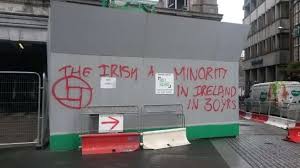Incitement of Hatred
 Anti-immigrant graffiti opposite the office of the Irish Immigration Council in Dublin, February 2014.
Anti-immigrant graffiti opposite the office of the Irish Immigration Council in Dublin, February 2014.
On April 3, 2014 Minister of Justice Alan Shatter’s house was sprayed with anti-Semitic graffiti.
On July 4, racist graffiti were discovered outside the Convention Centre in Dublin. On July 19, it was reported that a racist message was spray painted on the shutters of an ethnic food store in Carlow Town. On July 31, anti-Semitic graffiti was found in Dublin.
Racist graffiti was also found in Dublin in late December.
Homophobic leaflets have been distributed in Dublin in late December, saying that there will be “horrible consequences if homosexuals get access to the sanctity of marriage”.
There have been several xenophobic calls on the internet (particularly during the Waterford conflict).
Turning to more qualitative studies of hate crime during the period under study, there has been increasing amounts of focus within the academic community on everyday anti-Muslim prejudice in Ireland. As early as June 2014, Dr James Carr wrote a seminal academic report outlining ‘Experiences of Anti-Muslim Racism in Ireland’ for the University of Limerick’s Hate and Hostility Group.[1] What Carr found – based on interviews and focus group discussions with 345 Muslim Men and Women – was that Irish converts to Islam were particularly targeted as ‘traitors’ (p.3); that Muslims were treated as ‘suspect communities’ by police and society at large (p.4); and that a greater degree of anti-Muslim hostility was felt by individuals who were identifiable based on skin colour (47% of respondents)and other,cultural markers of ‘Muslimness’ (such as the wearing of the Hijab or SalwaarKameez)(45% of respondents) (p.5). In addition, he found that 36% of respondents had experienced some form of anti-Muslim racism – with 22% experiencing physical assaults, 20% harassment and 14% damage to personal property (p.3) –and that only 36% of victims reported anti-Muslim hostility (p.9).Finally, there was also a noticeably gendered aspect of this discrimination and hostility– with 96% of Muslim women who participated in the study suggesting that they had experienced some form hostility based on how they dressedcompared with just under half (45%) of the mensurveyed(p.6).
In a further (2015) study, DrCarr (along with his co-author, Amanda Haynes) focus on how transnational and local self-imaginings of race feed into perceptions of the Muslim community in Ireland. What they argue is that Muslims are caught between two different competing racializations – on the one hand an exclusionary form of Irishness and on the other a racialized form of Muslimness (p.21). They also argue that the Irish state’s lack of willingness to categorise anti-Muslim hatred as a specific offence is part of a wider dismantling of the apparatus to address racism, which reflects the neoliberalisation of race (ibid). Finally, and based on Carr’s PhD research into Anti-Muslim hostility in Ireland, what the authors find is that – of the 36% of participants stated as experiencing some form of anti-Muslim hostility – two-thirds reported that they did not refer it to any state entity (p.30). This was largely based on fear of the police, fear of reprisals in case they were identified to the perpetrator(s) and notions of futility around the reporting of hate crimes (pp.30-32). This again paints minority communities confidence in reporting hate crime in Ireland.
Finally, and turning the issue of homophobichate crime, it was very hard to gather up-to-date statistics surrounding this phenomena during the period under study. In May 2017, the main source of monitoring for anti-gay incidents, Ireland’s Gay and Lesbian Network, was closed following a review of its financial operations. This did not however serve to mask key homophobic incidents during the period under consideration. In August 2017, a gay man from County Sligo, Gary Daly, was head-butted, punched and bitten after kissing another man on a date. Moreover, in June 2017, reports emerged that young people returning from Dublin’s annual Pride event were subjected to homophobic abuse. Finally, a December 2017 report by NGO, Stop Transphobia and Discrimination Ireland, found that only 10% transphobic hate crimes are reported to the Irish Police – compared to 75% in Northern Ireland. Better training in hate crime directed towards transgendered people was seen as a key way to rectify underreporting.
In March 2021, the Irish Network Against Racism (INAR) (formerly known as ENAR Ireland) released its report detailing the 2020 findings from the iReport.ie racist incident reporting system.
Following the lockdown and COVID-19-related restrictions, new forms of racism and discrimination have emerged across the country. There has been a slight decrease in instances of direct discrimination and racism in institutions (with the largest decrease in reports concerning government employees) and street racism. To a large extent, all the activities of the radicals have moved online.
Irish far-right figures have shared COVID-19 conspiracy theories to energize their followers and incited violence using racist myths. This resulted in a record 69 reports relating to hate speech by far-right hate groups. Chinese, Asians, and minorities in general have been increasingly targeted both online and offline in some high-profile hate crimes, with perpetrators often blaming their victims for the pandemic and intentionally spreading the virus.
31 hate speech reports are directly related to the pandemic. Perhaps unsurprisingly, the biggest increase in posts has been related to online racism. There has also been an increase in the number of cases reported to the Gardai (Irish Police), with a 43% increase in 2020, much higher than the 13% increase in 2019. In total, according to INAR, 334 cases of hate speech were recorded in 2020.


